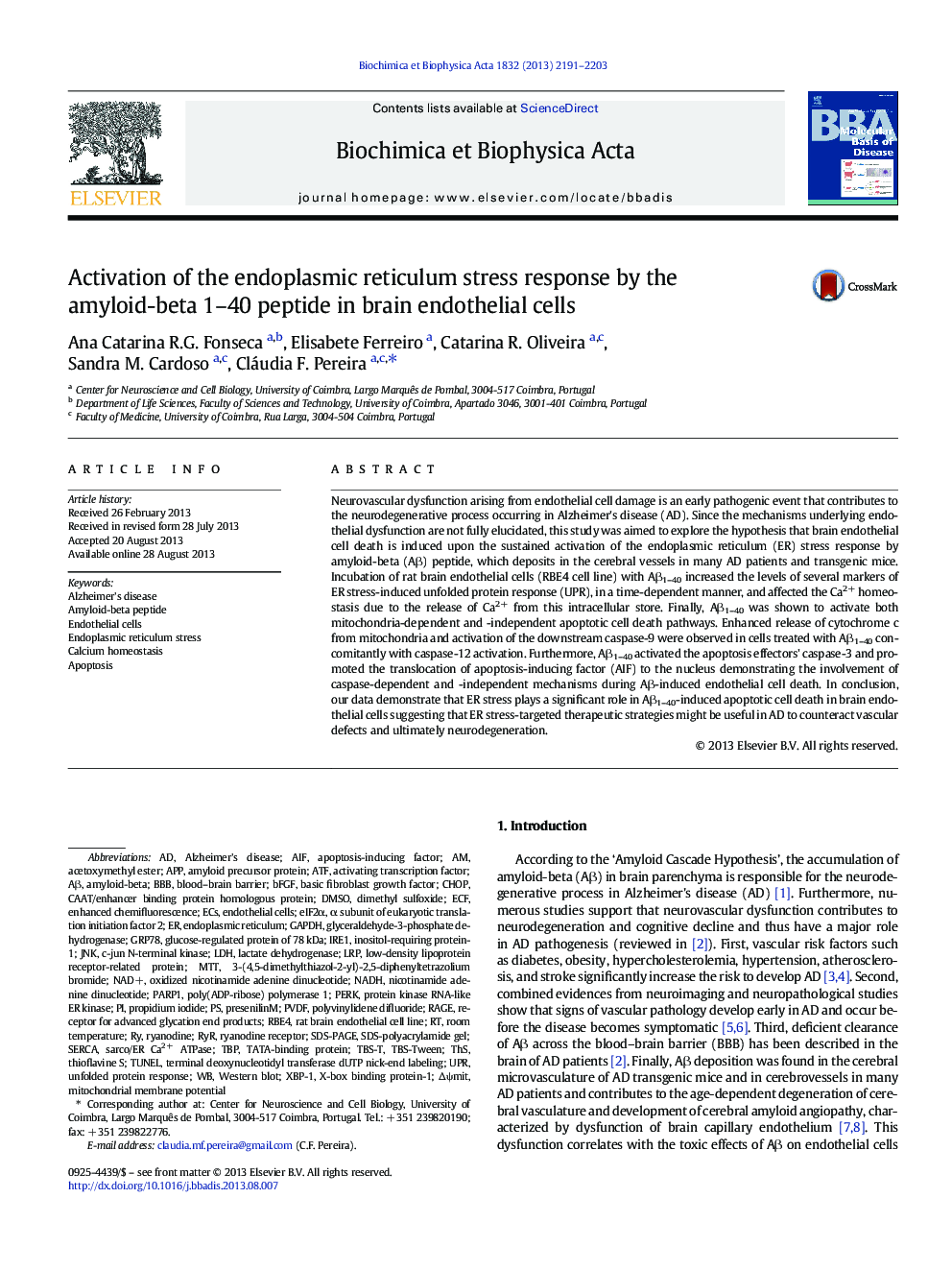| Article ID | Journal | Published Year | Pages | File Type |
|---|---|---|---|---|
| 8260754 | Biochimica et Biophysica Acta (BBA) - Molecular Basis of Disease | 2013 | 13 Pages |
Abstract
Neurovascular dysfunction arising from endothelial cell damage is an early pathogenic event that contributes to the neurodegenerative process occurring in Alzheimer's disease (AD). Since the mechanisms underlying endothelial dysfunction are not fully elucidated, this study was aimed to explore the hypothesis that brain endothelial cell death is induced upon the sustained activation of the endoplasmic reticulum (ER) stress response by amyloid-beta (Aβ) peptide, which deposits in the cerebral vessels in many AD patients and transgenic mice. Incubation of rat brain endothelial cells (RBE4 cell line) with Aβ1-40 increased the levels of several markers of ER stress-induced unfolded protein response (UPR), in a time-dependent manner, and affected the Ca2 + homeostasis due to the release of Ca2 + from this intracellular store. Finally, Aβ1-40 was shown to activate both mitochondria-dependent and -independent apoptotic cell death pathways. Enhanced release of cytochrome c from mitochondria and activation of the downstream caspase-9 were observed in cells treated with Aβ1-40 concomitantly with caspase-12 activation. Furthermore, Aβ1-40 activated the apoptosis effectors' caspase-3 and promoted the translocation of apoptosis-inducing factor (AIF) to the nucleus demonstrating the involvement of caspase-dependent and -independent mechanisms during Aβ-induced endothelial cell death. In conclusion, our data demonstrate that ER stress plays a significant role in Aβ1-40-induced apoptotic cell death in brain endothelial cells suggesting that ER stress-targeted therapeutic strategies might be useful in AD to counteract vascular defects and ultimately neurodegeneration.
Keywords
GRP78APPECFRyRTBS-TATFUPRGAPDHAβIRE1bFGFeIF2αRAGELRPTBS-tweenJnkinositol-requiring protein-1PARP1PVDFXBP-1TBPRBE43-(4,5-dimethylthiazol-2-yl)-2,5-diphenyltetrazolium bromidec-Jun N-terminal kinaseDMSOECsMTTTHsamyloid-betaAIFacetoxymethyl esterEndoplasmic reticulum stressSDS-PAGEoxidized nicotinamide adenine dinucleotideAlzheimer's diseaseterminal deoxynucleotidyl transferase dUTP nick-end labelingTUNELCHOPX-box binding protein-1ApoptosisRoom temperaturepolyvinylidene difluorideDimethyl sulfoxideRyanodineBBBBlood–brain barrierEndothelial cellsendoplasmic reticulumenhanced chemifluorescenceapoptosis-inducing factorbasic fibroblast growth factoractivating transcription factorSERCAlactate dehydrogenaseLDHNADHnicotinamide adenine dinucleotideCalcium homeostasisWestern blotUnfolded protein responseMitochondrial membrane potentialTATA-binding proteinLow-density lipoprotein receptor-related proteinamyloid precursor proteinprotein kinase RNA-like ER kinasePropidium iodidePERKPoly(ADP-ribose) polymerase 1amyloid-beta peptideglyceraldehyde-3-phosphate dehydrogenaseReceptor for advanced glycation end productsRyanodine receptor
Related Topics
Life Sciences
Biochemistry, Genetics and Molecular Biology
Ageing
Authors
Ana Catarina R.G. Fonseca, Elisabete Ferreiro, Catarina R. Oliveira, Sandra M. Cardoso, Cláudia F. Pereira,
